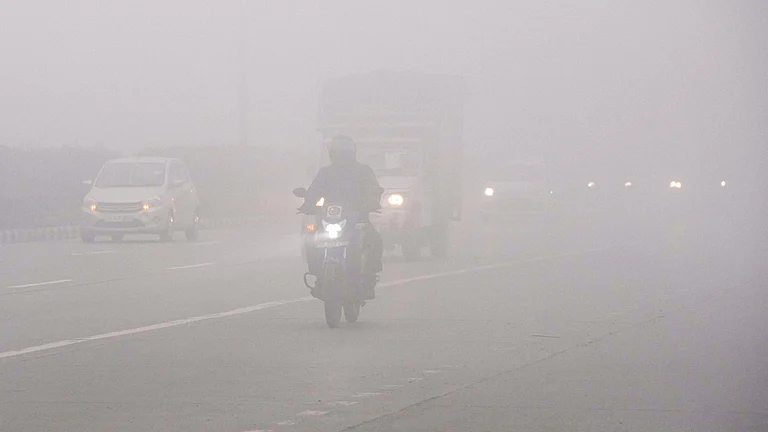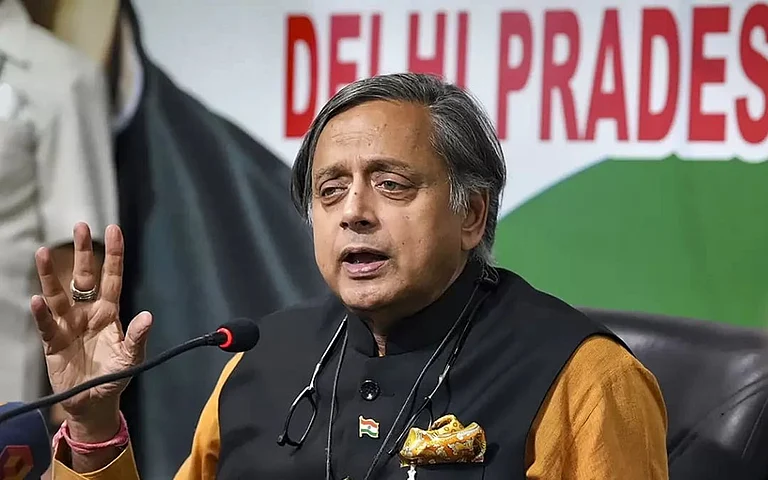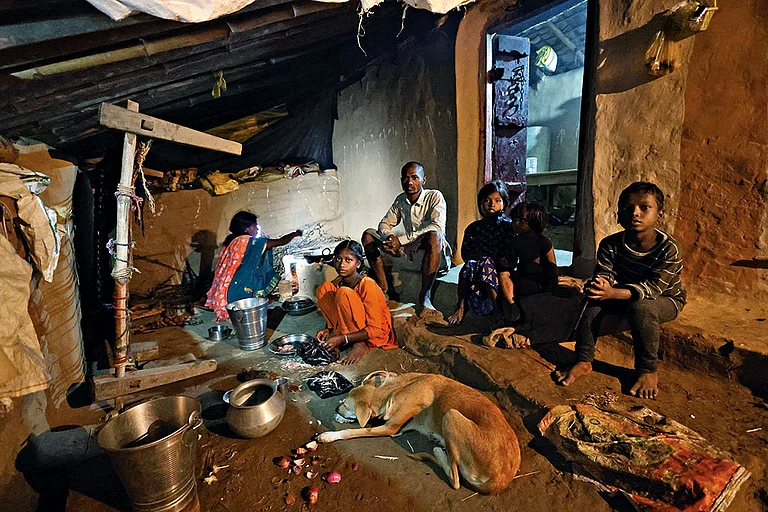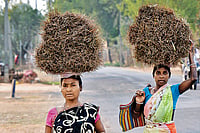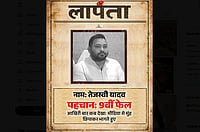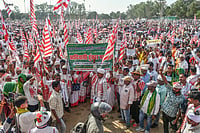For 15 years, Panchu Ravidas, 43, has been repairing footwear in a six-by-six kiosk in Bodh Gaya. His future is marked by the challenges of educating three children and feeding five people. However, at the moment, his happiness over the construction of the Ram temple far exceeds any of these worries. He regards the temple to be the most significant development of PM Narendra Modi's 10 years in power and it will be the decisive factor for him when he casts his vote for the next five years.
In Bihar, unemployment and migration for work remain major issues. A report found that two crore people have migrated from Bihar in search of work and an additional 40 lakh do so every year.
Is this not of any concern to people like Panchu? He says: “It’s true that there is no employment here. The leaders say that they will provide employment, but no one does anything about it. Everyone promised development, but that also did not happen. But the Ram temple has been built, so we will vote for Modi. The issue of the temple concerns everyone.”
Panchu’s feelings are shared by his 30-year-old customer Ranjan Kumar Singh. He too is very clear about who he will vote for and on which issues. He says, “The temple dispute was unresolved for five hundred years, but the BJP got it settled. Employment and migration are not issues. The people of Bihar will vote mostly over the Ram temple.”
Ranjan adds that he will vote for the BJP in these general elections because it will bring some change in Bihar, and the next time, the BJP will form a government on its own.
A Contest Between Two Sitting MLAs
Bihar’s Nawada, Aurangabad, Jamui, and Gaya are among the 102 seats that are going to poll in the first phase on April 19. Gaya is said to be the hottest seat as it has former Chief Minister Jitan Ram Manjhi in the fray. He is contesting from his party, Hindustani Awam Morcha (HUM), with the support of the National Democratic Alliance (NDA).
Manjhi, talked to Outlook about the abysmal speed of development among Dalits. He said, “The Dalits have risen, but at the speed of a crocodile, not like a Rajdhani or super-fast train. It's been more than 75 years [since Independence]”.
Highlighting that development indicators such as access to education is unequal even within Dalits, he said, “The country’s literacy rate has gone up to 80 per cent, but the figure for the SCs is only 28 per cent.The Bhuiyas and Musahars languish even lower, at 7 per cent. What does that tell us? It says that education is the milk of a lioness, whoever drinks it will roar. But no one is feeding it to us, so we are not roaring”.
To turn around the situation, Manjhi suggests that the focus should be to improve the condition of government schools so everyone in the country has access to the same level of quality education. “If the government makes a law to the effect that every child, whether she is the daughter of a government employee, a judge, or a collector, will be educated in a government school, then the condition of the government schools will begin to improve and our poor children who study in those schools will also see betterment in their lives.”
The main center of Manjhi's campaign is Bodh Gaya, which has 18 lakh voters and is very active politically. His rival candidate from the Rashtriya Janata Dal (RJD), Kumar Sarvjeet, is the current MLA from Bodhgaya. Sarvjeet’s candidacy is supported by the INDIA bloc. In all, there are 39 candidates in the four seats. Of these, Gaya has the maximum number of candidates at 14, although the real fight there is between the NDA and the INDIA. Both their candidates are sitting MLAs.
Talking to Outlook, Sarvjeet draws attention to the success of Mahagathbandhan (Grand Alliance) government and his own role in trying to resolve the unemployment issue the state faces. He said, “You need to evaluate, how many jobs were created in our 17-month term in office and how many during Nitish's 17-years as CM. When I was a minister, I had insisted in a cabinet meeting that we need to offer government jobs to people to check migration”.
He also linked the issue of migration out of state with the lack of jobs. He added, “As the people, who migrate for jobs, are exploited by private companies. Even when our people die (in the course of work) there is no compensation by the companies. When I give them jobs here, of course they would not migrate”.
Sarvjeet is banking on the work done during the Mahagatbandhan government. Recent job creation and regularisation in Bihar is being attributed to RLD leader, Tejashwi Yadav. “You see, Tejashwi has fulfilled his promise of offering 10 lakh jobs. Jobs were created by every department. However, the enemies of the poor and anti-social elements conspired to oust the government, and as a result, government jobs were not advertised anymore”, says Sarvjeet.
Gaya, famous as the land of knowledge and salvation, is known internationally. There have been 16 general elections on this seat since 1957. The Congress has won five times, the BJP four times, and the Janata Dal three times. The RJD, the Janata Dal (United) or JDU, the Bharatiya Lok Dal (BLD), and the Jana Sangh have each won the election once.
Sidelining Development Issues
In the village of Rampur, located at a distance of two km from Manjhi’s house in Bodh Gaya, there is jubilation over the construction of the Ram temple, but that does not seem to form the basis of voting choices. Shyamdev Yadav, 67, had voted for the BJP in the name of PM Modi in 2019, but now he is very angry with Modi.
He says: “I voted for Modi ji the last time. But what did he do? The prices of everything have gone up. The gas rate has doubled. They had said that the old age pension would be increased, but that did not happen. It was said that Rs 5 lakh would be given through the smart card. No such thing happened. The farmers are in a bad state. The Ram temple has been built. It is a good thing. We are happy. But tell us whether we will get food from the temple. Modi ji should tell us how much was spent on the development of the poor vis-à-vis the money expended on building the temple.”
According to Yadav, the people in his village will vote for Sarvjeet in the Lok Sabha elections, because whatever little development the village has seen has been during Sarvjeet’s legislative term. He says that the road and the hand pump were delivered by Sarvjeet.
Journalist Khatibullah shares that in these elections, there is no talk by any leader about unemployment, inflation, migration, education, and health. There is only talk of the temple and the abrogation of Article 370. He adds, however, that things like the temple and Article 370 do not have much impact among the people.
The residents of Rampur believe that Manjhi and Chief Minister Nitish Kumar are alike in a major respect: no one can predict when they will switch their allegiance. Jawani Bhagat, 60, calls them “Paltu Rams” (turncoats). He says: “A man who does not remain steadfast in his commitment is as useless as a river that is without water. Our votes will go to someone who is true and steady, and not to those who switch sides.”
The villagers say that Manjhi’s ministerial aspirations have taken him to parties like the BJP, the RJD, and the JDU. Similarly, Nitish Kumar has variously joined hands with the BJP and the RJD to remain the CM. These political antics have eroded people’s faith in them.
Understanding The Caste Equation
The Lok Sabha seat of Gaya is a Scheduled-Caste reserved seat. There are six assembly seats under it, of which three are currently held by the RJD. Election data make it clear that the parties here tend to bet on Mahadalit candidates generally. Among the Dalits, the largest number of people, about three lakh, belongs to the Manjhi caste.
Apart from this, the Paswan, Dhobi, and Pasi communities, too, have sizeable populations. Among the backward castes, there are more than two and a half lakh Yadavs. The populations of about 2.25 lakh Muslims, 2.5 lakh Bhumihars, and the Rajputs also play an important role in deciding the electoral outcome.
Khatibullah explains the caste equations thus, “The Manjhi community is dominant among the Dalits. It has large populations in the Aurangabad, Nawada, and Gaya Lok Sabha constituencies. In the last 20 years, the Manjhis have also become aware of their rights. Their literacy rate has improved a lot. In 2005, it was only six per cent. I believe that this change is also driven by the schemes run by Chief Minister Nitish Kumar.”
Another senior journalist, S Ahmed, says: “Not only in Gaya, but in all of Bihar and UP as well, the distribution of seats and electoral strategies hinge on caste equations. Gaya is no exception in this respect. If you take a look [at the past decades], you will notice that this seat has been held mostly by the Manjhi community. They have been winning continuously for the past 25 years. And the fight is between these castes. For example, we can see that the two main contenders at present are a Manjhi and a Paswan.”
Both Khatibullah and Ahmed believe that though the caste equation in Gaya seems to favour the NDA, still that the fight is neck to neck, hence it is difficult to predict where victory will land.
Sarvjeet's Stature Vis-à-vis Manjhi
The Lok Sabha contest in Gaya is interesting in many ways. Both the leading candidates are sitting MLAs, and both have also been ministers in the Bihar government. However, if we talk about political stature, Sarvjeet comes up short before Manjhi.
The political journey of 80-year-old Manjhi began with the Congress in 1980. Subsequently, he was with the Janata Dal, the RJD, and the JDU. Then in 2015, he formed his own party. Born on October 6, 1944, in the Mehkar village of Khizersarai in the Gaya district, Manjhi was an MLA eight times during his 44 years in politics, and a minister during the tenure of seven different chief ministers. He was elected MLA for the first time in 1980.
In 2014, he also became the Chief Minister for almost a year. His record of contesting and winning the legislative elections from four different assembly seats in Gaya adds to his stature. According to election analysts, Jitan Ram Manjhi is viewed as the biggest leader of the Manjhi community in the Magadh region.
However, when it comes to Lok Sabha elections, Manjhi has not been so successful. A four-time contender, he has not won a single parliamentary election. It is believed that if he wins it this time, he will certainly be made a minister at the Centre.
The 49-year-old Sarvjeet is the son of late Rajesh Kumar, who became the MP from Gaya in 1992 and was also a three-time MLA from Bodh Gaya. After the murder of his father in 2005, Sarvjeet entered politics. He is a two-time MLA from Bodh Gaya and was a minister in the previous Mahagathbandhan government of Bihar.
It is an interesting coincidence that when Manjhi contested the Lok Sabha elections for the first time in 1992, he lost to Rajesh Kumar. Now in his fourth bid, his chief adversary is Kumar’s son Sarvjeet.
(Translated by Kaushika Draavid)








